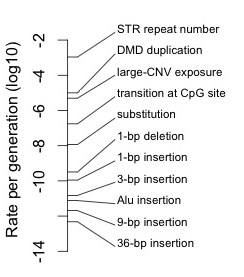April 17, 2015 / Arlin Stoltzfus / 0 Comments
To understand the potential role of mutation in evolution, it is important to understand the enormous range of rates for different types of mutations. If one ignores this, and thinks of “the mutation rate” as a single number, or if one divides mutation into point mutations with a characteristic rate, and other mutations that are ignored, one is going to miss out on how rates of mutation determine what kinds of changes are more or less common in evolution. It would be like allowing a concept of fitness, then subverting its utility by distinguishing only two values, viable and inviable. [1]

(more…)
April 16, 2015 / Arlin Stoltzfus / 7 Comments
Last year Sahotra Sarkar published a paper that got me thinking. His piece entitled “The Genomic Challenge to Adaptationism” focused on the writings of Lynch & Koonin, arguing that molecular studies continue to present a major challenge to the received view of evolution, by suggesting that “non-adaptive processes dominate genome architecture evolution”.
The idea that molecular studies are bringing about a gradual but profound shift in how we understand evolution is something I’ve considered for a long time. It reminds me of the urban myth about boiling a frog, to the effect that the frog will not notice the change if you bring it on slowly enough. Molecular results on evolution have been emerging slowly and steadily since the late 1950s. Initially these results were shunted into a separate stream of “molecular evolution” (with its own journals and conferences), but over time, they have been merged into the mainstream, leading to the impression that molecular results can’t possibly have any revolutionary implications (read more in a recent article here).

Frog on a saucepan (credit: James Lee; source: http://en.wikipedia.org/wiki/Boiling_frog)
(more…)
April 14, 2015 / Arlin Stoltzfus / 8 Comments
Debates on “gradualism” in evolutionary biology address the size distribution of evolutionary changes. The classical Darwinian position, better described as “infinitesimalism”, holds that evolutionary change is smooth in the sense of being composed of an abundance of infinitesimals (not one infinitesimal at a time, but a blending flow of infinitesimals). The alternative is that evolution sometimes involves “saltations” or jumps, i.e., distinctive and discrete steps. The dispute between these two positions has been a subject of acrimony at various times in the 20th century, with several minor skirmishes, and a larger battle with at least one genuine casualty (image).

Walter Frank Rafael Weldon (public domain image from wikipedia). Weldon ignored an advancing illness and worked himself to death (1906) poring over breeding records in an attempt to cast doubt on discrete inheritance. Along with Pearson and other “biometricians”, Weldon held to Darwin’s non-Mendelian view combining gradual hereditary fluctuations with blending inheritance.
Today, over a decade into the 21st century, we have abundant evidence for saltations, yet the term is virtually unknown, and we still seem to invoke selection under the assumption of gradualism. Are we saltationists, or not? I’m going to offer 3 answers below.
But first, we need to review why the issue is important for evolutionary theory.
(more…)


